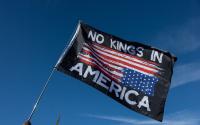25 December 2006Michael Barbaro
Retailers are calling it the Coat Crisis of 2006, a fashion fiasco measured in racks of unsold fur-lined shearlings at Saks Fifth Avenue in New York and hooded wool peacoats at the Galeries Lafayette department store in Paris.
Balmy temperatures on the East Coast of the United States and in Western Europe have been disastrous for sales of all kinds of cold-weather clothing, from cashmere caps to wool scarves.
What seemed like a meteorological aberration — the coatless, hatless, gloveless morning commute in Washington, New York, Boston and Paris — is starting to feel like the new normal, encouraging consumers to splurge on a flat-screen television instead of cold- weather garments.
The glut of winter wear has sent a chill through the executive suites of major retailers, who count on big profits from coats in the crucial holiday shopping season.
They are even starting to grumble about the first "global warming Christmas."
Despite a sudden cold snap in Paris, the coat department of Galeries Lafayette on the Boulevard Haussmann was almost devoid of shoppers on Saturday, an odd contrast to the pre-Christmas rush elsewhere.
Elsa Mendez browsed through a selection of peacoats, but said that she was not sure she would buy anything. "I normally get my coat in October, but this year it was so mild that I kept putting it off," she said. Despite the frosty temperatures outside, she said she might wait until the traditional winter sales in January.
All across Europe, meteorologists have been recording milder temperatures this year. The Met Office, Britain's national weather service, said this month that 2006 had been the warmest year since record-keeping began in 1659, while Austria's Central Institute for Meteorology and Geodynamics heralded this winter as the warmest in 1,300 years.
On the U.S. East Coast, average highs this holiday season have been 15 degrees Fahrenheit, or 4 degrees Celsius, warmer than last year.
Nicole Boussard, a saleswoman in Paris for Fuchs Schmitt, a German maker of women's outerwear, stood alone at her cash register on Saturday, catching up on paperwork and bemoaning the slow pace of sales. "It's true, everyone is complaining this year," she said of her colleagues.
So like farmers praying for rain, merchants have begun scanning weather forecasts, hoping for a sudden drop in temperature to lift their sales.
"At first, you start to chuckle in the morning," when the temperature hits 50 degrees Fahrenheit, or 10 degrees Celsius, said Rick Weinstein, director of sales and marketing at Searle, a New York retailer that supplies coats to high- end department stores, "then you start to snicker and then you start to curse."
A few days before Christmas, temperatures remained in the mid-40s Fahrenheit, or around 7 degrees Celsius, from Maryland to Maine. Alex Grossman, a New York City resident, buys a new winter coat every holiday season, waiting until the first cold snap. This year, it never came.
"Now it's so late in the season I won't even buy one," he said, standing sans coat in the center of New York last week as temperatures reached 45 degrees Fahrenheit.
NPD Group, a retail research firm, predicts that sales of outerwear will plunge at least 20 percent this holiday season, compared with last year, with the not-winterlike weather to blame.
Retailers will not report holiday sales figures until January, but there are clear signs of trouble — and not just the clogged sales aisles. Even apparel executives, generally an optimistic group, are acknowledging there is a problem.
"It's a fact of life: you need cold weather to sell cold-weather products," said Barry Kay, co-president of Herman Kay, a clothing company in New York that supplies coats to department stores like Macy's and J.C. Penney. The season, he said, "has been very tough."
"I am still running in shorts," Kay said of his morning jogs through Central Park. "That is not a good thing."
But warm weather is not the only obstacle this year to selling heavy winter coats, scarves and gloves. Several seasons ago, consumers starting wearing more layers, stacking corduroy blazers over cashmere sweaters over collared shirts over long-sleeve T-shirts — rendering heavy coats unnecessary in all but the coldest weather.
Boussard, the Parisian saleswoman, agreed weather was only part of the problem. "For the past three years, coats in Paris have been very trendy, and the collections were more colorful and fashionable," Boussard said. "The coat boom seems to be over."
At the same time, millions of Americans are buying gift cards for friends and family members, rather than cashmere overcoats and down vests. By the time many people get around to cashing in their gift cards, jackets may be out of season.
"It's a triple whammy," said John Morris, senior retail analyst at Wachovia Securities, who tracks sales at mall stores. "Retailers are getting caught with their pants down — and their coats off."
So from popularly priced chains like Gap to high-end stores like Barney's, retailers are cutting prices, with the coat department transformed into a sea of pleading sale signs.
Even if temperatures remain unusually warm, the season is unlikely to become a total washout for retailers.
Michael Fink, head of women's fashion at Saks, said that even in warm seasons like this one, "The key fashion coats sell no matter what."
"It's not about warmth," he said, "it's about want."
The real worry is that this holiday season will not be an anomaly. Retail executives and clothing designers are generally the last to weigh in on scientific debates, but some fear that they are seeing hints of global warming.
"The warm weather this season is really bringing it home," said Dana Buchman, who creates women's clothing for high-end department stores "What is scary is that people are saying it's nice. It's not good news. It's scary."
Scientists are less sure. While they have concluded that the global climate is warming because of trapped greenhouse gases in the atmosphere, extremes in any one season cannot be firmly linked to an underlying trend.






